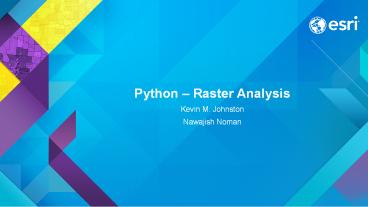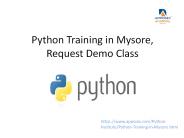Python - PowerPoint PPT Presentation
Title:
Python
Description:
Python Raster Analysis Kevin M. Johnston Nawajish Noman Demo Movement by flight 20 km per year Vegetation type/ash density (suitability) Classes Using ... – PowerPoint PPT presentation
Number of Views:114
Avg rating:3.0/5.0
Title: Python
1
Python Raster Analysis
- Kevin M. Johnston
- Nawajish Noman
2
Outline
- Managing rasters and performing analysis with Map
Algebra - How to access the analysis capability
- Demonstration
- Complex expressions and optimization
- Demonstration
- Additional modeling capability classes
- Demonstration
- Full modeling control NumPy arrays
- Demonstration
3
A complex model
Emerald Ash Borer
Originated in Michigan Infest ash trees 100
kill Coming to Vermont
4
The Ash Borer model
- Movement by flight
- 20 km per year
- Vegetation type and ash density (suitability
surface) - Movement by hitchhiking
- Roads
- Camp sites
- Mills
- Population
- Current location of the borer (suitability
surface) - Random movement
5
Typical problem just like yours The
Characteristics
- Complex
- Multiple input types
- Need to work with rasters along with features and
tables - Scenarios
- Repeat analysis by using different parameter
values - Dynamic
- Time is explicit, need to run sections multiple
times - Enhanced capabilities
- Need to take advantage of 3rd party Python
packages - Reusable
- Repeat the workflow with the same or different
set of data - Performance and optimization
Ideal for Map Algebra and Python scripting
6
The Ash Borer model
- Prepare the data
- An iterative model based on a year
- Three sub models run individually each iteration
and the results are combined - Movement by flight (run 3 different seasons)
- Movement by hitchhiking (run once)
- Random movement (run once)
7
Raster analysis Preparing the data
- To prepare and manage raster data
- Displaying
- Adding, copying, deleting, etc.
- Mosaic, Clip, etc.
- Raster object
- NumPy, ApplyEnvironment, etc.
- To perform analysis
- Spatial Analyst
- Map Algebra
8
What is Map Algebra
- Simple and powerful algebra to execute Spatial
Analyst tools, operators, and functions to
perform geographic analysis - The strength is in creating complex expressions
- Available through Spatial Analyst module
- Integrated in Python (all modules available)
9
Importing Spatial Analyst
- Module of ArcPy site package
- Like all modules must be imported
- To access the operators and tools in an algebraic
format the imports are important
import arcpy from arcpy import env Analysis
environment from arcpy.sa import
10
General syntax
- Map Algebra available through an algebraic format
- Simplest form output raster is specified to the
left of an equal sign and the tool and its
parameters on the right - Comprised of
- Input data - Operators
- Tools - Parameters
- Output
from arcpy.sa import outRas Slope(indem)
11
Input for analysis
- Rasters
- Features
- Numbers and text
- Objects
- Constants
- Variables
Tip It is good practice to set the input to a
variable and use the variable in the expression.
Dataset names are quoted.
inRaster1 "C/Data/elevation outRas
Slope(inRaster1)
12
Map Algebra operators
- Symbols for mathematical operations
- Many operators in both Python and Spatial Analyst
- Creating a raster object (Raster class
constructor - casting) indicates operator should
be applied to rasters
outRas inRaster1 inRaster2
elevMeters Raster("C\data\elevation")
0.3048 outSlope Slope(elevMeters)
13
Map Algebra tools
- All Spatial Analyst tools are available (e.g.,
Sin, Slope, Reclassify, etc.) - Can use any Geoprocessing tools
outRas Aspect(inRaster)
Tip Tool names are case sensitive
14
Tool parameters
- Defines how the tool is to be executed
- Each tool has its own unique set of parameters
- Some are required, others are optional
- Numbers, strings, and objects (classes)
- Slope(in_raster, output_measurement,
z_factor) - outRas Slope(inRaster, DEGREE, 0.3048)
- outRas Slope(inRaster, , 0.3048)
- outRas Slope(inRaster)
- Tip Keywords are in quotes
1
2
3
1
O
O
2
3
15
Map Algebra output
- Stores the results as a Raster object
- Object with methods and properties
- In scripting the output is temporary
- Associated data will be deleted if not explicitly
saved
16
Access to Map Algebra
- Raster Calculator
- Spatial Analyst tool
- Easy to use calculator interface
- Stand alone or in ModelBuilder
- Python window
- Single expression or simple exploratory models
- Scripting
- Complex models
- Line completion and colors
17
The Ash Borer model
- Prepare the data
- An iterative model based on a year
- Three sub models run individually each iteration
and the results are combined - Movement by flight (run 3 different seasons)
- Movement by hitchhiking (run once)
- Random movement (run once)
18
Demo
- Data management and accessing the capability
- Raster management tools
- Raster Calculator
- Python window
- Model Builder
- Simple expression
19
Outline
- Managing rasters and performing analysis with Map
Algebra - How to access the analysis capability
- Demonstration
- Complex expressions and optimization
- Demonstration
- Additional modeling capability classes
- Demonstration
- Full modeling control NumPy arrays
- Demonstration
20
Complex expressions
- Multiple operators and tools can be implemented
in a single expression - Output from one expression can be input to a
subsequent expression
inRaster ExtractByAttributes(inElevation,
"Value gt 1000") out Con(IsNull(inRaster), 0,
inRaster)
21
More on the raster object
- A variable with a pointer to a dataset
- Output from a Map Algebra expression or from an
existing dataset - The associated dataset is temporary (from Map
Algebra expression) - has a save method - A series of properties describing the associated
dataset - Description of raster (e.g., number of rows)
- Description of the values (e.g., mean)
outRas Slope(inRaster) outRas.save("sloperaster"
)
22
Optimization
- A series of local tools (Abs, Sin,
CellStatistics, etc.) and operators can be
optimized - When entered into a single expression each tool
and operator is processed on a per cell basis
23
The Ash Borer model
- Prepare the data
- An iterative model based on a year
- Three sub models run individually each iteration
and the results are combined - Movement by flight (run 3 different seasons)
- Movement by hitchhiking (run once)
- Random movement (run once)
24
Movement by hitchhiking
- Hitchhike on cars and logging trucks
- Most likely spread around
- Roads
- Populated areas (towns and camp areas)
- Commercial area (mills)
- Have a susceptibility surface
- Vegetation types and density of ash
- Nonlinear decay
- Random points and check susceptibility
25
Demo
- Movement by hitchhiking
- Roads, campsites, mills, population,
- and current location (suitability)
- Complex expressions
- Raster object
- Optimization
26
Outline
- Managing rasters and performing analysis with Map
Algebra - How to access the analysis capability
- Demonstration
- Complex expressions and optimization
- Demonstration
- Additional modeling capability classes
- Demonstration
- Full modeling control NumPy arrays
- Demonstration
27
Classes
- Objects that are used as parameters to tools
- Varying number of arguments depending on the
parameter choice (neighborhood type) - The number of entries can vary depending on
situation (remap table) - More flexible
- Query the individual arguments
28
Classes - Categories
- General
- Fuzzy - Time
- Horizontal Factor - Vertical Factor
- KrigingModel - Radius
- Neighborhood - Transformation functions
- Composed of lists
- Reclass - Weighted reclass tables
- Topo
29
General classes - Capability
- Creating
- Querying
- Changing arguments
neigh NbrCircle(4, "MAP")
radius neigh.radius
neigh.radius 6
30
Classes composed of lists
- Topo
- Reclassify
- Weighted Overlay
inContours TopoContour('contours.shp',
'spot_meter')
remap RemapValue("Brush/transitional", 0,
"Water", 1,"Barren land", 2)
myWOTable WOTable(inRaster1, 50, "VALUE",
remapsnow, inRaster2, 20, "VALUE", remapland,
inRaster3, 30, "VALUE", remapsoil , 1, 9,
1)
31
Vector integration
- Feature data is required for some Spatial Analyst
Map Algebra - IDW, Kriging, etc.
- Geoprocessing tools that operate on feature data
can be used in an expression - Buffer, Select, etc.
dist EucDistance(arcpy.Select_analysis("schools"
, "", "Popgt2000"))
32
The Ash Borer model
- Prepare the data
- An iterative model based on a year
- Three sub models run individually each iteration
and the results are combined - Movement by flight (run 3 different seasons)
- Movement by hitchhiking (run once)
- Random movement (run once)
33
Movement by flight
- Fly from existing locations - 20 km per year
- Based on iterative time steps
- Spring, summer, fall, and winter
- Time of year determines how far it can move in a
time step - Suitability surface based on vegetation type and
ash density - Iterative movement logic
- Is there a borer in my neighborhood
- Will I accept it suitability surface
34
Demo
- Movement by flight
- 20 km per year
- Vegetation type/ash density
- (suitability)
- Classes
- Using variables
- Vector integration
35
Outline
- Managing rasters and performing analysis with Map
Algebra - How to access the analysis capability
- Demonstration
- Complex expressions and optimization
- Demonstration
- Additional modeling capability classes
- Demonstration
- Full modeling control NumPy arrays
- Demonstration
36
NumPy Arrays
- A generic Python storage mechanism
- Create custom tool
- Access the wealth of free tools built by the
scientific community - Clustering
- Filtering
- Linear algebra
- Optimization
- Fourier transformation
- Morphology
37
NumPy Arrays
- Two tools
- RasterToNumPyArray
- NumPyArrayToRaster
38
The Ash Borer model
- Prepare the data
- An iterative model based on a year
- Three sub models run individually each iteration
and the results are combined - Movement by flight (run 3 different seasons)
- Movement by hitchhiking (run once)
- Random movement (run once)
39
Random movement
- Some of the movement cannot be described
deterministically - Nonlinear decay from known locations
- Specific decay function not available in ArcGIS
- NumPy array
- Export raster
- Apply function
- Import NumPy array back into a raster
- Return to ash borer model and integrate three
movement sub models
40
Demo
- Random movement
- Random movement based on nonlinear
- decay from existing locations
- Custom function
- NumPy array
41
Summary
- When the problem becomes more complex you may
need additional capability provided by Map
Algebra - Map Algebra powerful, flexible, easy to use, and
integrated into Python - Accessed through Raster Calculator, Python
window, ModelBuilder (through Raster Calculator),
and scripting - Raster object and classes
- Create models that can better capture interaction
of phenomena
42
(No Transcript)































